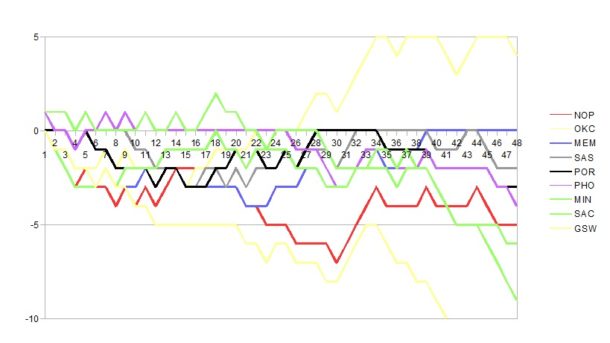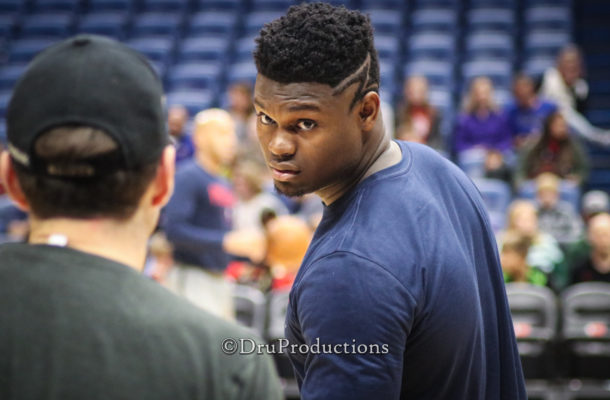Apparently, “Let’s Dance!” is referring to a two-step. The return of Zion Williams has been, overall, what I expected. He’s showing quickly that the hype is justified, and that Zion is certainly a talent to watch as one that might be the best player in the NBA one day. I certainly need to see what the rest of the season brings before making any stronger proclamation. His mid-season introduction has also caused some disruptions to the rotations and flow. Despite his spark and contributions, the team was 0-2 after his debut, then 3-0, rounding out 3-2 going into February and the first game of the month against the Rockets.
As I wrote about the other day, the Pelicans have needed to get to the line more regularly. They have been, too. There are two good reasons for this:
- Free throws are very efficient
- A team that relies on the 3-point shots needs free throws to help offset poorer shooting nights
The former is a general point with merit, especially when you are putting your opponent on the line far more often than you get there, which was the case for New Orleans for a large stretch of the season.
The latter point holds water for teams that rely on 3-pointers. While the three-point shots have a better efficiency overall than mid-range jumpers, the make rate is still less, especially when compared to 2-pointers generally. Aside from the rebounds and need for defense entailed in this, the volatility in scoring is a hidden cost. A handful of free throws is a good way to remove some of the pressure from the defense and get some scoring in to plug the hole due to variance or help with the stiff-arm or straight burial of an opponent.
Let’s add a little analysis to help out. The NBA averages about 34 (33.7) 3-pointers per game (we want per game here) and the average make-rate is about 35.5%. The Pelicans are about 4 points above this (37.4). Checking the per-possession numbers confirms this is not just pace. Let’s go with the empirically-supported claim that this is strategic, and the choice is deliberate. These shots are then coming from 2-pointers, as the per possession numbers confirm.
It’s a convenient thought that these 3-pointers are converted long 2-pointers, but this is not really the case. Rather, though their percentage of shots that are 3-pointers is among league leaders, and they take long-2-pointers at about 95% of the typical mix factor as the NBA average. They also take the closest shots at about 105% of the NBA-typical mix rate. The in-between shots are taken at lower factors, though. A side effect of this is going to the line less, which is reflected in the numbers. The Pelicans are not good from these ranges, and in fact their make-rates are about that on 3-pointers.
The fewer and worse shots from mid-mid-range is likely a culprit for them not getting to the line. Ingram is the consistent contributor from that range and the guy consistently getting to the line. Next is Hayes. Getting to line helps to offset the empties. Zion can and likely will help here. Not only has he shown some shooting capacity that hints at some direct contributions, he can help weaken the defense a little to help his teammates make those mid-mid-range shots at a better rate or get some fouls. He’ll clearly get to the line himself, too, but he’s not great there. He’s main contribution will be to help get the team to the bonus so others shoot free throws more often.
Mid-range shots get some proper and improper criticism. They serve a purpose. The Pelicans need to at least attempt them a little more and make them a little more to keep the defense honest unless they are going to add more 26-30 ft shots to the mix.
Standings
The New Orleans Pelicans sit at 20-29 with 33 games left to play, going 4-2 since the last real look at the standings. Their performance in January was 9-6, hitting the mark I set for them. Winning just over 60% from there, going 20-13, is not crazy, and 40-42 might just be enough for the 8th spot.
They’ve split recent games against key opponents, winning 2 against Memphis and losing 1 against San Antonio. This month, there are only 2 key matchups, both against Portland.
February is a rough month, so I’m thinking they need to go 5-5, then 15-8 to make the 20-13 mentioned above. The outcome of those two Portland games could really influence that. The Pelicans need to at least split that pair.
Here is a look at the the aligned standings after 48 games, relative to 8th.

I’ll leave you with some key standings + schedule data.
Here are some tables of how key series affect each teams’ ability to reach 40 wins.
| Pelicans Win | | | | Pelicans Need | | | | Spurs Need |
|---|---|---|---|---|
| 0 | 20 of 30 | 15 of 31 | ||
| 1 | 19 of 30 | 16 of 31 | ||
| 2 | 18 of 30 | 17 of 31 | ||
| 3 | 17 of 30 | 18 of 31 | ||
| Pelicans Win | | | | Pelicans Need | | | | Grizzlies Need |
|---|---|---|---|---|
| 2 | 20 of 31 | 14 of 31 | ||
| 3 | 19 of 31 | 15 of 31 | ||
| 4 | 18 of 31 | 16 of 31 |
| Pelicans Win | | | | Pelicans Need | | | | Trail Blazers Need |
|---|---|---|---|---|
| 2 | 20 of 31 | 15 of 30 | ||
| 3 | 19 of 31 | 16 of 30 | ||
| 4 | 18 of 31 | 17 of 30 |
| Pelicans Win | | | | Pelicans Need | | | | Suns Need |
|---|---|---|---|---|
| 1 | 20 of 32 | 19 of 33 | ||
| 2 | 19 of 32 | 20 of 33 | ||
| Matchup | | | | Games Remaining |
|---|---|---|
| Grizzlies – Spurs | 1 | |
| Grizzlies – Suns | 0 | |
| Grizzlies – Trail Blazers | 3 | |
| Spurs – Suns | 0 | |
| Spurs – Trail Blazers | 1 | |
| Suns – Trail Blazers | 2 |
Grizzlies – Trail Blazers is noteworthy. One of those teams is going to walk away with 2 or 3 wins guaranteed. You don’t know which one it is, but one of those two team has at least 2 more wins than you think they do right now.
This won’t be easy.
Let’s Dance.
